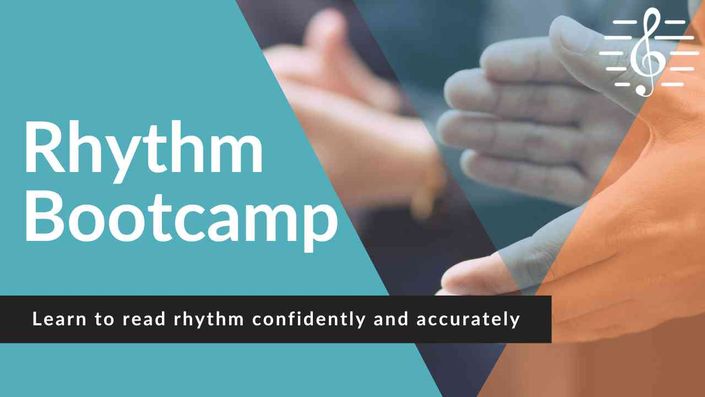

What You Will Learn
Build a reliable internal pulse, learn rhythm, timing, metre and more with the Rhythm Bootcamp course.
Rhythm Bootcamp is an exciting course that explores how to read rhythm with accuracy and confidence. A systematic approach is taken that transforms the grasp of written rhythm from reading note values to knowing exactly when the next note has to be played and how exactly the placing of rhythms relates to the metre and pulse. This tried and tested method will entirely liberate your ability to read and deliver rhythm with assurance. During the Rhythm Bootcamp course we'll cover...
- Music Notation - How long does a note or a rest last? How does beaming help you read music? What do you need to know about time signatures, triplets and duplets?
- Auditory Skills - Can you count and feel a reliable sense of pulse? How do you clap rhythms in simple and compound time? What effect does syncopation or accentuation have on rhythm?
- Conducting - Why do you need to know about conducting? How does a conductor keep players or singers in time? How does rhythm give music character?
- Irregular Rhythms - How do rhythms work in 5, 7, 10, 11 and 13 time? How do you clap irregular time divisions like quintuplets? How do you go about conducting a piece with an irregular time signature?
- Complex Variations - How do you read two against three? What is a polyrhythm? How do you clap two rhythms simultaneously?
Of all the places I know of I think MM is the place to go. I really like the combination of a fine intellect and a fine psyche. For me, Gareth has a special meaning in my life since he was the person who kick-started my theoretical foundation, I am most grateful for that. You keep it up guys!
- Carl

Who Is This Course For?
Each and every musician ready to revolutionse their rhythmic ability.
Isolating rhythm from pitch lets you focus your attention on mastering rhythm which is the most fundamental element of music. The Rhythm Bootcamp course interlocks both theory and aural dimensions to support your rhythm traning journey. Once you have a solid foundation in rhythm, learning the other elements of music will be much easier and quicker.
Do any of these sound familiar?
"I have a certain feel for rhythm but some of the theory essentials are missing from my knowledge..." "When I read a rhythm I find it difficult to hear what it should be just by looking at it..." "I do okay reading a single rhythm but it falls apart when I have to read two or more rhythms simultaneously…" "I’m not always sure how a rhythm relates to what a conductor is doing..." "I understand rhythm myself but would like to know a good way to teach the accurate reading of rhythm…"
↓
Thank you for everything that you do, Gareth. You have been just as influential to me, if not more, than any music school I could have went to.
- Peter

By the end of the Rhythm Bootcamp course you'll be able to…

Read rhythm accurately and fluently in Simple, Compound and irregular time signatures

Be able to make an aural connection with the rhythms you read in a score

Understand all the theoretical aspects of rhythm

Be able to relate rhythm to a conductor’s beat

Be able to read more than one rhythm at a time

Play more confidently knowing what you are doing is right
Thank you for your inclusive, friendly approach to music teaching. I never feel talked down to or like it’s too late to grow. Inspirational stuff.
- Andreas

Course Information
What's Included with the Rhythm Bootcamp Course?
Professional Teaching
You'll receive expert training, thoroughly enabling you to develop an accurate and confident understanding of rhythm.
Practical Exercises
Each video teaches you the method for reading rhythm and then follows it by relating it to working example questions.
Ask Questions
Below each video you are able to post comments and ask questions should you have any in regards to the course topics covered.
Easy to Follow Structure
The course is divided into multiple stages, breaking down each part separately before putting it all together.
Complete at Your Own Pace
You can easily fit the course around your regular commitments, completing it at your own pace and in your own time.
Anywhere Access
Your course never expires. Learn when and where you choose! Computer or mobile. Just get comfortable and dive in!
↓
Your Instructor

Hi, I’m Gareth and I'm passionate about developing ‘the all round musician’.
Over 35 years of music examining with ABRSM, work with the BBC on Radio and TV, experience on the international concert platform, as a published composer and arranger, have brought rich resources to the 40 years of teaching in which I've engaged.
Scholarships at The Royal College of Music, Oxford University and St. Paul’s Cathedral gave me fantastic opportunities to learn from the best musicians, scholars and teachers. Working as Director of Music at Queen Elizabeth Grammar School then provided a wonderful opportunity to develop my teaching skills.
Teaching individuals and groups of all ages, and at all stages of development have refined a teaching approach that I hope is fun and engaging, and focused on explaining things clearly and logically. And that is what these courses are all about - understanding the basic principles with clarity, then going deeper, applying them to your musical life and liberating yourself as a musician.
It’s a rich and amazing journey, and I can’t wait for you to join me today!
Course Curriculum
-
PreviewLesson 1 - Introduction (7:03)
-
StartLesson 2 - Feeling the Pulse (20:10)
-
StartLesson 3 - Note Values (17:53)
-
StartLesson 4 - Note Values 2 (16:13)
-
StartLesson 5 - Rests (12:48)
-
PreviewLesson 6 - Pulse, Tempo and Rhythm (41:09)
-
StartLesson 7 - Time Signatures, Bars and Barlines (22:30)
-
StartLesson 8 - Clapping a Pulse and Emphasising Strong Beats (20:57)
-
StartLesson 9 - Conducting in 2, 3 and 4 Time (11:05)
-
StartLesson 10 - Clapping Notated Rhythms in Simple Time (40:34)
-
StartLesson 11 - Notating Rhythms from Sound in Simple Time (59:19)
-
StartLesson 12 - Beaming in Simple Time (20:18)
-
StartLesson 13 - Tied Notes Explained (5:02)
-
StartLesson 14 - Clapping Rhythms using Tied Notes (17:01)
-
StartLesson 15 - Triplets Explained (14:07)
-
StartLesson 16 - Clapping Rhythms Involving Triplets and Ties (15:03)
-
StartLesson 17 - Hearing Triplets (10:55)
-
StartLesson 18 - What is Simple Time? (14:54)
-
StartLesson 19 - Clapping Rhythms in 2/2, 3/2, 4/2, 3/8, 4/8, 3/16 (32:36)
-
StartLesson 20 - What is Compound Time? (12:23)
-
StartLesson 21 - Beaming in Compound Time (28:12)
-
StartLesson 22 - Clapping Rhythms in Compound Time (48:50)
-
StartLesson 23 - Conducting in Compound Time (17:22)
-
StartLesson 24 - Duplets (12:55)
-
PreviewLesson 25 - Clapping Rhythms in Compound Time, Including Duplets (21:19)
-
StartLesson 26 - Hearing Duplets (8:46)
-
StartLesson 27 - Irregular Time Signatures (16:13)
-
StartLesson 28 - Conducting in Irregular Time (16:53)
-
StartLesson 29 - Clapping Rhythms in 5 and 7 Time (20:55)
-
StartLesson 30 - Clapping Rhythms in 10, 11 and 13 Time (17:20)
-
StartLesson 31 - Syncopation (24:12)
-
StartLesson 32 - Hearing Syncopation (12:40)
-
StartLesson 33 - Displaced Accentuation in Rhythm (21:42)
-
StartLesson 34 - Irregular Time Divisions Explained (7:44)
-
StartLesson 35 - Clapping Rhythms Including Irregular Time Divisions (23:07)
-
StartLesson 36 - Clapping Rhythms Involving Rests (27:16)
-
StartLesson 37 - Clapping Rhythms Involving Anacrusis (19:12)
-
StartLesson 38 - Clapping Two Rhythms Simultaneously (32:59)
-
StartLesson 39 - Converting Between Simple and Compound Time (28:39)
-
StartLesson 40 - Reading Two against Three (16:27)
-
StartLesson 41 - Polyrhythms (11:09)
-
StartLesson 42 - Swing Rhythms (8:24)
-
StartLesson 43 - How Rhythm Gives Character (12:54)
-
StartLesson 44 - Harmonic Rhythm (9:21)
-
StartLesson 45 - Putting It All Together (23:56)
-
StartNote Values Quiz 1
-
StartNote Values Quiz 2
-
StartNote Values Quiz 3
-
StartRests Quiz 1
-
StartRests Quiz 2
-
StartRests Quiz 3
-
StartSimple Time Signature Quiz
-
StartSimple Time Bar Lines Quiz
-
StartSimple Time Beaming Quiz 1
-
StartSimple Time Beaming Quiz 2
-
StartSimple Time Beaming Quiz 3
-
StartSimple Time Beaming Quiz 4
-
PreviewAdditional Time Signature Quiz
-
StartCompound Time Signature Quiz
-
StartCompound Time Beaming Quiz 1
-
StartCompound Time Beaming Quiz 2
-
StartCompound Time Beaming Quiz 3
-
StartCompound Time Beaming Quiz 4
Frequently Asked Questions
A Letter from Gareth Green
MA (Oxon), MA (Leeds), FRCO(CHM), FLCM, ARCM
In over 30 years of examining I’ve consistently observed how often pitch is more secure than rhythm in the performance of pieces, and more significantly in the area of sight reading. Why is this, especially taken that most musicians can identify rhythmic values with reasonable confidence? My theory is that there is a disconnect between knowledge and understanding. In other words, most musicians can identify that a note needs to be sustained for two beats or for one and a half beats but this remains no more than isolated information.
The important thing is to be able to apply that information to a succession of rhythms in the music. The key question is not ‘how long do I need to hold on to this note?’ but ‘when do I need to play the next note?’ In order to be confident about the latter question we need to relate the printed rhythm to the metre, the pulse, and the position in the bar. Instead of hoping that the rhythm will be right because we know we have ‘two beats followed by one and a half beats followed by half a beat’ we need to translate that into ‘the first note begins on beat one, the second note begins on beat three, and the third note begins on the second half of beat four’. Once we relate that to a reliable pulse we are in a much stronger position to deliver the rhythm accurately.
This course builds a method on the concept outlined above, starting with elementary rhythms and increasing the complexity of rhythm step by step as the course unfolds. As we journey through the course we will ensure the accurate grasp of the essential theoretical skills and we will develop associated aural skills but the course is essentially practical, offering you repeated opportunities to read, clap and play rhythms until they are fully embedded.
By the end of this course you will have an assured grasp of rhythm. So come and join me on this exciting and liberating musical journey, and never again be bewildered by rhythm!
— Gareth Green, Music Matters




